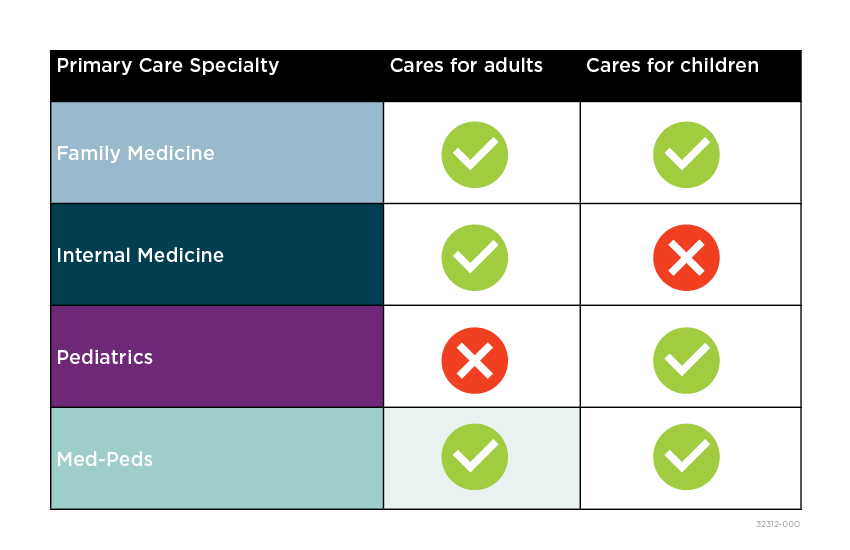A primary care provider is a doctor, nurse practitioner or physician assistant who follows your overall health care needs. This care may include:
- Providing you an annual wellness check-up

- Providing you with annual immunizations
- Providing health risk assessments and recommending screenings
- Ordering labs or imaging (like an X-ray) to ensure you are healthy
- Providing you with a referral to see a specialty doctor
- Care if you are sick or have an injury
“Ultimately a primary care provider’s responsibility is to work with you to find health concerns and solutions to those concerns,” said Dr. Jennifer Strong, family medicine physician at Marshfield Clinic Health System. “This may look like sending you to an oncologist for cancer treatments or simply prescribing you a medication for a skin rash.”
RELATED ARTICLE: Wellness checkup: A physical examination by your family doctor
Primary care provider specialties
Primary care providers can specialize in family medicine, internal medicine, pediatrics and med-peds. A primary care provider may also be a doctor (M.D. or D.O.), nurse practitioner (N.P.) and physician assistant (P.A.-C), which are typically shown using letters after their name.
These specialties and credentials describe the education and training the provider completed.
RELATED ARTICLE: Difference between MD, DO, NP and PA-C primary care providers
“When you come in for a wellness check-up, you may not notice any difference between a family medicine nurse practitioner or an internal medicine physician,” said Dr. Strong. “That is because most wellness check-ups are pretty standard.”
Download primary care specialties quick reference guide

Below are common primary care provider specialties you may encounter when looking for a primary care provider and what each means.
What is a family medicine doctor?
Family medicine is the most common specialty that provides primary care services. This specialty can provide care for both children and adults.
During residency, family medicine doctors had to learn in both a hospital and clinic setting. This included training in these six medical areas: pediatrics, OB/GYN, internal medicine, psychiatry and neurology, surgery and community medicine.
Following the completion of training, a family medicine doctor must pass a test to become a board-certified family medicine doctor.
Learn more about family medicine.
What is an internal medicine doctor?
Internal medicine provides primary care services for adults. They are trained to handle complex health issues such as severe long-term illnesses or multiple health conditions.
During a 3-year residency, internal medicine medicine doctors had to learn in both a hospital and clinic setting. This typically includes training in many medical specialties including heart care, cancer care, neurology, geriatrics and many more.
After an internal medicine residency, doctors can receive additional fellowship training to become a specialist (for example, a cardiologist or oncologist).
Following the completion of training, an internal medicine doctor must pass a test to become a board-certified internal medicine doctor.
Learn more about internal medicine.
What is a pediatrician?
Pediatric medicine providers provide primary care services for children, adolescents and young adults.
During a 3-year residency, pediatricians had to learn in both a hospital and clinic setting. This included training in various pediatric specialties such as newborns, general pediatrics and developmental-behavioral pediatrics.
After a pediatric residency, doctors can receive additional fellowship training to become a specialist (for example, a pediatric cardiologist or pediatric oncologist).
Following the completion of training, a pediatrician must pass a test to become a board-certified pediatrician.
Learn more about pediatrics.
What is a Med-Peds doctor?
Some providers choose to specialize in Med-Peds, which is short for “Combined Internal Medicine and Pediatrics.” A Med-Peds provider can provide primary care services for both children and adults.
Med-Peds doctors must complete both an internal medicine and pediatric residency, which includes training in those corresponding specialties. This typically takes four years.
After a Med-Peds residency, doctors can receive additional fellowship training to become a specialist.
Following the completion of training, a Med-Peds doctor must pass the pediatric and internal medicine board certification test to become a board-certified Med-Peds doctor.
Learn more about Med-Peds.
Nurse practitioners and physician assistants
All of these primary care specialties can have nurse practitioners and physician assistants providing care.
A nurse practitioner is a registered nurse that has their master’s or doctorate in nursing that included time in a clinic. They then completed a nurse practitioner exam to receive their board certification.
A physician assistant completed a masters-level program that included time in a clinic. They then must pass an exam to receive their state license.
A doctor typically oversees the work of a nurse practitioner and physician assistant.
RELATED ARTICLE: Difference between MD, DO, NP and PA-C primary care providers
Schedule an appointment with a Marshfield Clinic Health System primary care provider.
Schedule appointment Learn more about Primary Care
Related Shine365 articles
Difference between MD, DO, NP and PA-C primary care providers
Wellness checkup: A physical examination by your family doctor






Leave a Reply